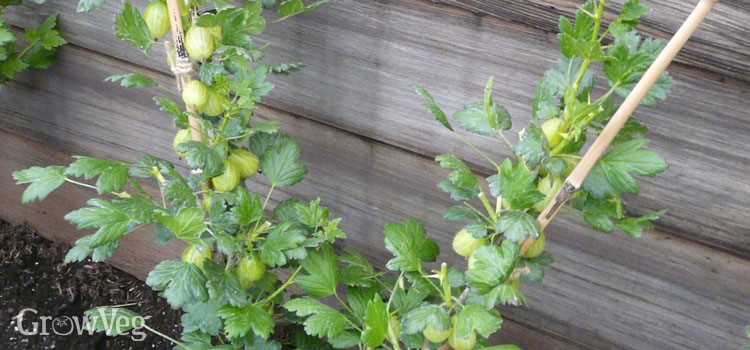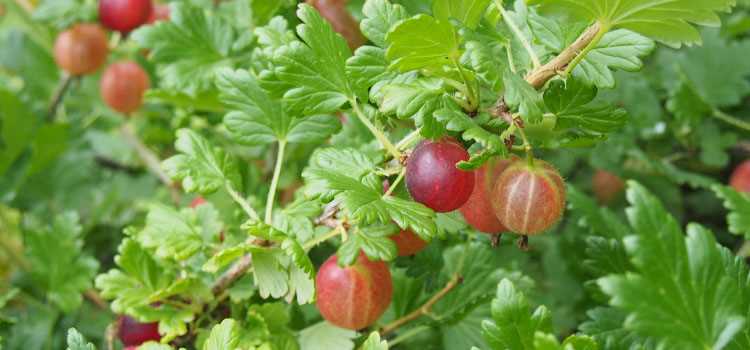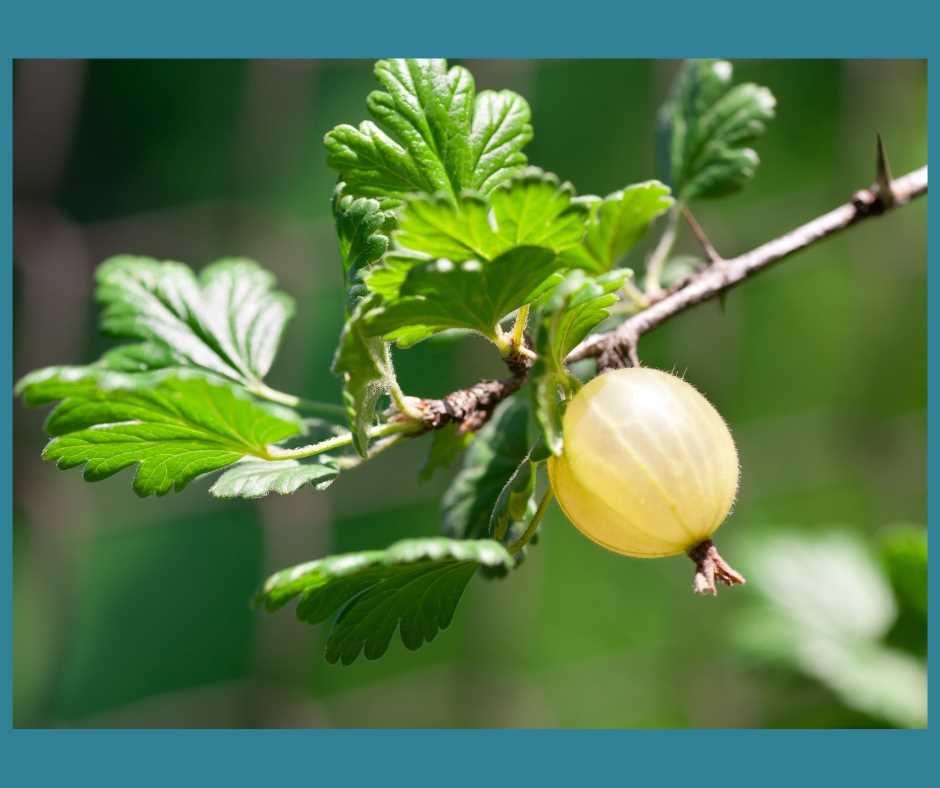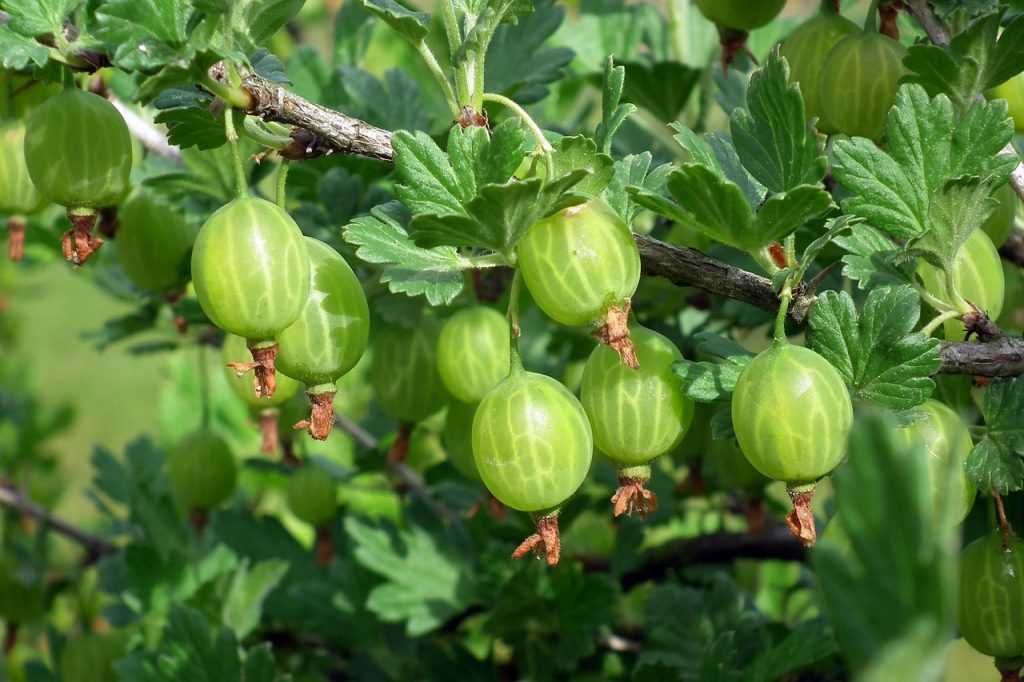- Why Spring Care for Gooseberries is Important
- The Benefits of Proper Spring Care for Gooseberries
- 1. Promotes Healthy Growth
- 2. Prevents Pest Infestations
- 3. Enhances Fruit Production
- 4. Improves Fruit Quality
- 5. Extends the Lifespan of the Plants
- Preparing the Soil for Healthy Gooseberries
- 1. Selecting the Site
- 2. Clearing the Area
- 3. Soil Testing
- 4. Digging and Amending the Soil
- 5. Mulching
- 6. Watering
- Pruning and Training Gooseberry Plants
- 1. Prune in late winter or early spring
- 2. Remove any dead or diseased wood
- 3. Thin out crowded branches
- 4. Train the main stem
- 5. Prune for fruit production
- 6. Maintain an open center
- 7. Mulch and fertilize
- Controlling Pests and Diseases in Gooseberry Plants
- Pests
- Diseases
- Fertilizing Gooseberries for Optimal Growth
- 1. Soil Testing
- 2. Nitrogen Fertilizers
- 3. Phosphorus and Potassium Fertilizers
- 4. Organic Fertilizers
- 5. Mulching
- 6. Watering
- Watering Techniques for Gooseberry Plants
- 1. Watering Frequency
- 2. Deep Watering
- 3. Mulching
- 4. Watering in the Morning
- 5. Drip Irrigation or Soaker Hoses
- 6. Avoid Overwatering
- Protecting Gooseberries from Harsh Weather Conditions
- 1. Winter Protection
- 2. Protecting from Frost
- 3. Shielding from Strong Winds
- 4. Protecting from Heavy Rainfall
- Harvesting and Storing Gooseberries for Maximum Flavor
- 1. Harvesting:
- 2. Sorting and Cleaning:
- 3. Storing:
- 4. Flavor Enhancement:
- Question-answer:
- What are some tips for spring care for gooseberries?
- When is the best time to prune gooseberries?
- What should I do to prevent diseases in gooseberry plants?
- How often should I water my gooseberry plants in spring?
- Should I fertilize my gooseberry plants in spring?
- Why is mulching important for gooseberry plants in spring?
- Video: Growing Gooseberries from Planting to Harvest

When it comes to growing gooseberries, proper care in the springtime is crucial for ensuring a bountiful harvest of delicious berries. Gooseberries are hardy plants that can withstand cold temperatures, but they require some attention in the spring to thrive. By following a few simple steps, you can ensure that your gooseberries will produce healthy berries that are bursting with flavor.
One of the first things you should do in the spring is to prune your gooseberry bushes. Pruning helps to promote airflow and sunlight penetration, which can prevent diseases and increase fruit production. Remove any dead or damaged branches, as well as any branches that are crossing or rubbing against each other. It’s also a good idea to thin out the center of the bush to allow for better air circulation.
Fertilizing your gooseberries in the spring is also important for their overall health and productivity. Use a balanced, slow-release fertilizer that is specifically formulated for fruit-bearing plants. Spread the fertilizer around the base of the bush, being careful not to let it come into direct contact with the stems or leaves. Water the fertilizer into the soil thoroughly to ensure that it is absorbed by the roots.
Lastly, don’t forget to mulch your gooseberry bushes in the spring. Mulching helps to conserve moisture, suppress weeds, and regulate soil temperature. Spread a layer of organic mulch, such as wood chips or straw, around the base of the bush, leaving a small gap around the stems. This will help to keep the soil moist and prevent competition from weeds.
By taking the time to care for your gooseberry bushes in the spring, you can ensure that they will grow strong and healthy, and reward you with a plentiful harvest of delicious berries. Follow these simple steps and enjoy the satisfaction of growing your own tasty gooseberries!
Why Spring Care for Gooseberries is Important
Gooseberries are a delicious and nutritious berry that can be enjoyed in a variety of recipes, from jams and pies to sauces and desserts. To ensure a bountiful harvest of healthy berries, it is crucial to provide proper care for gooseberries in the spring.
1. Promotes Growth: Spring care, such as pruning and fertilizing, helps stimulate new growth in gooseberry bushes. By removing dead or damaged branches and encouraging the development of new shoots, the plant can thrive and produce more berries.
2. Prevents Disease: Spring is the ideal time to inspect gooseberry plants for signs of disease or pests. By identifying and treating any issues early on, you can prevent the spread of diseases, such as powdery mildew or aphid infestations, which can significantly damage the health of the plant and reduce berry production.
3. Improves Air Circulation: Proper care in the spring also includes pruning to improve air circulation within the gooseberry bush. This helps to reduce the risk of fungal diseases, as well as allows sunlight to reach all parts of the plant, ensuring optimal growth and berry production.
4. Enhances Fruit Quality: With the right care during the spring, you can improve the overall quality of the gooseberries. By providing the necessary nutrients and water, you can promote larger berries with better flavor and texture.
In conclusion, spring care for gooseberries plays a crucial role in promoting growth, preventing disease, improving air circulation, and enhancing fruit quality. By dedicating time and effort to care for your gooseberry bushes in the spring, you can enjoy a healthy and abundant harvest of delicious berries.
The Benefits of Proper Spring Care for Gooseberries


Proper spring care is essential for gooseberries to ensure healthy growth and maximize fruit production. By providing the right care in the spring, you can enjoy a bountiful harvest of delicious and nutritious berries. Below are some key benefits of giving proper spring care to your gooseberries.
1. Promotes Healthy Growth
Spring care involves pruning and shaping the gooseberry bushes. Pruning helps remove any dead or diseased branches, stimulates new growth, and improves air circulation. Proper shaping ensures that the bush maintains an open and structured form, allowing sunlight to reach all parts of the plant. This promotes healthy growth and prevents the development of fungal diseases.
2. Prevents Pest Infestations
By conducting thorough inspections during spring care, you can identify and eliminate any potential pest problems before they become a major issue. Removing debris and fallen leaves from around the bushes helps eliminate hiding places for pests. Applying organic pest control methods, such as introducing beneficial insects, can further prevent infestations and protect your gooseberries.
3. Enhances Fruit Production
Proper spring care sets the foundation for a successful fruit harvest. Pruning stimulates the growth of new shoots, which are the primary fruit-bearing branches. By removing excess shoots and thinning out the canopy, you ensure that the plant directs its energy towards producing high-quality fruits. This reduces competition among the berries and allows for better air circulation, reducing the risk of diseases.
4. Improves Fruit Quality
By providing the necessary spring care, you can improve the quality of your gooseberries. Adequate sunlight and air circulation help the berries ripen evenly and develop their full flavor. Regular watering, fertilization, and mulching also ensure that the plants receive the essential nutrients they need to produce plump, juicy berries with a sweet and tangy taste.
5. Extends the Lifespan of the Plants
Proper care in the spring not only benefits the current growing season but also extends the lifespan of your gooseberry plants. Pruning and shaping the bushes reduce the risk of disease and encourage healthy growth, allowing the plants to thrive year after year. By investing time and effort in spring care, you can enjoy a fruitful gooseberry patch for many seasons to come.
In conclusion, proper spring care for gooseberries is crucial for promoting healthy growth, preventing pest infestations, enhancing fruit production, improving fruit quality, and extending the lifespan of the plants. With the right care, you can enjoy a plentiful harvest of delicious and nutritious gooseberries.
Preparing the Soil for Healthy Gooseberries
Before planting gooseberries, it is essential to prepare the soil properly to provide the plants with the best possible growing conditions. A well-prepared soil will ensure healthy growth and abundant harvests. Here are some steps to prepare the soil for growing healthy gooseberries:
1. Selecting the Site
Choose a site with full sun exposure for your gooseberry plants. They need at least six to eight hours of direct sunlight daily to thrive. The chosen area should also have good drainage to prevent waterlogged soil.
2. Clearing the Area
Remove any existing plants, weeds, or grass from the planting area. These can compete with the gooseberry plants for nutrients and water. It is recommended to remove weeds by hand rather than using chemicals to maintain the soil’s health and prevent contamination.
3. Soil Testing
It is essential to know the pH level of your soil. Gooseberries prefer slightly acidic soil with a pH level of 6.0 to 6.5. Conduct a soil test to determine the pH level. Depending on the test results, you may need to adjust the soil’s acidity by adding lime to raise the pH or sulfur to lower it.
4. Digging and Amending the Soil
Loosen the soil to a depth of about 12 inches using a garden fork or tiller. Remove any large rocks, roots, or debris that may hinder root growth. Add organic matter such as compost, well-rotted manure, or leaf mold to improve soil fertility and drainage. Work the organic matter into the soil evenly.
5. Mulching
Apply a layer of mulch around the gooseberry plants to conserve moisture, suppress weed growth, and regulate soil temperature. Organic mulches, such as straw, wood chips, or shredded leaves, work best for gooseberries.
6. Watering
After planting the gooseberry plants, water them thoroughly. Subsequently, water the plants regularly, especially during dry periods. Gooseberries require consistent moisture but should not be waterlogged.
By following these steps, you can ensure that your soil is adequately prepared for growing healthy and productive gooseberries. Proper soil preparation sets a solid foundation for the long-term success of your gooseberry plants.
Pruning and Training Gooseberry Plants
Pruning and training gooseberry plants is essential for their proper growth and the production of healthy berries. Here are some tips on how to prune and train your gooseberry plants:
1. Prune in late winter or early spring
It is best to prune your gooseberry plants when they are dormant, in late winter or early spring before new growth starts. This allows you to remove any dead or damaged wood and shape the plant for optimal growth.
2. Remove any dead or diseased wood
Inspect the plant for any dead or diseased wood and remove it by cutting it back to healthy growth. This helps prevent the spread of diseases and encourages the growth of new, healthy wood.
3. Thin out crowded branches
If your gooseberry plant has branches that are crowded or crossing over each other, it is important to thin them out. This allows for better airflow and sunlight penetration, reducing the risk of diseases and improving the overall health of the plant.
4. Train the main stem
Gooseberry plants have a main stem or leader that should be trained to grow upright. This helps to promote a strong and healthy plant structure. You can tie the main stem to a stake for support and guidance.
5. Prune for fruit production
To encourage optimal fruit production, prune your gooseberry plant to remove some of the older wood. This stimulates the growth of new wood, which is where the majority of the berries will develop. It is recommended to remove about one-third of the older wood each year.
6. Maintain an open center


Gooseberry plants should have an open center, which allows for better airflow and sunlight penetration. This helps to prevent diseases and promotes healthier growth. Remove any branches that are growing towards the center of the plant.
7. Mulch and fertilize
After pruning, apply a layer of mulch around the base of the gooseberry plant to help retain moisture and suppress weed growth. Additionally, fertilize the plant with a balanced fertilizer to provide it with the nutrients it needs for healthy growth.
By following these pruning and training tips, you can help ensure the longevity and productivity of your gooseberry plants, resulting in a bountiful harvest of delicious berries.
Controlling Pests and Diseases in Gooseberry Plants
Gooseberry plants are susceptible to a number of pests and diseases that can damage the health and productivity of the berries. Implementing proper pest and disease control measures can help ensure the longevity and productivity of your gooseberry plants.
Pests
There are several pests that commonly affect gooseberry plants, including:
- Aphids: Aphids are small, soft-bodied insects that feed on the sap of gooseberry plants. They can cause leaf curling and distortion, as well as transmit viruses.
- Gooseberry sawfly: The gooseberry sawfly is a type of caterpillar that feeds on the leaves of gooseberry plants, causing defoliation.
- Gooseberry fruitworm: The gooseberry fruitworm is a small, yellowish-green caterpillar that burrows into the berries, resulting in damage and reduced fruit quality.
To control these pests, you can:
- Inspect your plants regularly for signs of pest infestation.
- Remove and destroy any infested leaves or berries.
- Use insecticidal soap or neem oil to control aphids.
- Handpick and destroy gooseberry sawfly larvae.
- Apply a biological insecticide containing Bacillus thuringiensis to control gooseberry fruitworm.
Diseases
Common gooseberry diseases include:
- Mildew: Powdery mildew is a fungal disease that can cause a white, powdery coating on the leaves and stems of gooseberry plants. It can lead to leaf curling and reduced fruit production.
- Leaf spot: Leaf spot is a fungal disease that causes circular, dark spots on the leaves of gooseberry plants. If left untreated, it can lead to defoliation and weakened plants.
- Anthracnose: Anthracnose is a fungal disease that causes dark, sunken lesions on the stems, leaves, and fruits of gooseberry plants. It can result in reduced fruit quality and yield.
To control these diseases, you can:
- Plant resistant gooseberry varieties.
- Ensure proper spacing between plants to promote air circulation.
- Remove and destroy affected plant parts.
- Apply fungicides according to the manufacturer’s instructions.
By implementing these pest and disease control measures, you can help keep your gooseberry plants healthy and productive.
Fertilizing Gooseberries for Optimal Growth
Proper fertilization is crucial for the optimal growth of gooseberries. It ensures that the plants have all the essential nutrients they need to develop healthy foliage and produce a bountiful crop of berries. Here are some key points to keep in mind when fertilizing gooseberries:
1. Soil Testing


Before applying any fertilizers, it is important to test the soil in which your gooseberries are growing. A soil test will provide you with valuable information about the nutrient levels and pH of the soil. Based on the results, you can tailor your fertilizer application to meet the specific needs of your plants.
2. Nitrogen Fertilizers
Nitrogen is an essential nutrient for the growth of gooseberries. It promotes vigorous foliage growth and helps in the formation of berries. Apply nitrogen-rich fertilizers, such as ammonium nitrate or urea, in early spring before the plants start actively growing. Be careful not to exceed the recommended dosage, as excessive nitrogen can lead to excessive vegetative growth with fewer berries.
3. Phosphorus and Potassium Fertilizers
Phosphorus and potassium are also important nutrients for the overall health and fruit production of gooseberries. Apply a balanced fertilizer, such as a 10-10-10 or 14-14-14 blend, in early spring or late fall to provide these essential nutrients to the plants. Follow the manufacturer’s instructions for the correct application rate.
4. Organic Fertilizers
If you prefer using organic fertilizers, there are several options available for feeding gooseberries. Compost and well-rotted manure are excellent sources of nutrients and organic matter. Apply them in early spring or late fall, incorporating them into the soil around the base of the plants. You can also use organic fertilizers specifically formulated for berries or fruit trees.
5. Mulching
In addition to fertilizing, applying a layer of organic mulch around the base of the plants is beneficial for gooseberries. Mulch helps retain soil moisture, suppresses weed growth, and gradually releases nutrients into the soil as it breaks down. Use straw, wood chips, or leaf mulch and apply a layer of 2-4 inches around the plants, being careful to keep the mulch away from the stems.
6. Watering
Ensure that your gooseberries receive adequate water to maximize the effectiveness of the fertilizers. Water deeply and regularly, especially during dry periods or when the plants are fruiting. Avoid overwatering, as it can lead to root rot and other diseases.
By following these fertilizing tips, you can provide your gooseberries with the essential nutrients they need for optimal growth and a healthy, abundant berry harvest.
Watering Techniques for Gooseberry Plants
Proper watering is essential for the health and productivity of gooseberry plants. Here are some watering techniques to help you keep your gooseberries well-hydrated:
1. Watering Frequency
During the growing season, it is important to water gooseberry plants regularly, especially during dry periods. Aim to water them once or twice a week, ensuring that the soil around the plants remains consistently moist.
2. Deep Watering
When watering gooseberry plants, it is crucial to apply enough water to penetrate deep into the soil. This encourages the roots to grow deeper, making the plants more resilient to drought conditions. Water deeply until the soil is saturated to a depth of at least 6 inches.
3. Mulching
Applying a layer of organic mulch around gooseberry plants can help retain moisture in the soil and reduce weed growth. Spread a 2-3 inch layer of mulch, such as straw or wood chips, around the base of the plants, making sure to leave a small gap around the stem to prevent rot.
4. Watering in the Morning
It is best to water gooseberry plants in the morning, as this allows the foliage to dry out during the day. Watering in the evening or at night can create a damp environment, increasing the risk of fungal diseases.
5. Drip Irrigation or Soaker Hoses
Consider using drip irrigation or soaker hoses to water gooseberry plants. These methods deliver water directly to the root zone, minimizing water loss through evaporation. They also help prevent splashing water onto the leaves, which can lead to foliar diseases.
6. Avoid Overwatering
While it is important to keep gooseberry plants well-hydrated, overwatering can be detrimental to their health. Make sure to monitor the moisture level of the soil and avoid excessive watering, as it can lead to root rot and other problems.
By following these watering techniques, you can ensure that your gooseberry plants receive the right amount of water they need to thrive and produce healthy berries.
Protecting Gooseberries from Harsh Weather Conditions


When it comes to protecting gooseberries from harsh weather conditions, there are a few key steps you can take to ensure the health and productivity of your berry bushes.
1. Winter Protection
The harsh winter weather can pose a threat to gooseberries. To protect the plants from freezing temperatures and heavy snowfall, it is important to apply a layer of mulch around the base of the plants. This will help insulate the roots and prevent them from getting damaged.
Additionally, you can consider wrapping the branches with burlap or other protective material to shield them from strong winds and cold temperatures. This will help prevent the branches from breaking or drying out.
2. Protecting from Frost
Frost can be especially damaging to gooseberries, as it can kill the flowers and prevent fruit from forming. To protect your plants from frost, you can use frost covers or blankets. These can be placed over the plants during frosty nights to provide a layer of insulation.
It is also advisable to avoid planting gooseberries in low-lying areas where frost is more likely to occur. Instead, choose a location that is elevated and well-drained to minimize the risk of frost damage.
3. Shielding from Strong Winds
Strong winds can cause damage to gooseberry plants by breaking branches or uprooting them entirely. To protect your plants from strong winds, you can create windbreaks using materials like fences, hedges, or windbreak netting.
Position the windbreaks on the side of your garden where the prevailing winds come from to provide the maximum protection. This will help redirect the airflow and reduce the impact on your gooseberry plants.
4. Protecting from Heavy Rainfall
Excessive rainfall can lead to waterlogged soil, which can cause root rot and other diseases in gooseberries. To prevent this, ensure that your garden soil is well-drained. You can achieve this by incorporating organic matter, such as compost, into the soil before planting.
In addition, consider planting gooseberries on raised beds or mounds to further improve drainage. This will help prevent the plants from sitting in water and developing root issues.
By following these steps, you can protect your gooseberry plants from the harsh weather conditions and ensure a healthy and productive harvest.
Harvesting and Storing Gooseberries for Maximum Flavor
Harvesting gooseberries at the right time and storing them properly can greatly enhance their flavor and preserve their quality. Here are some tips on how to harvest and store gooseberries for maximum flavor:
1. Harvesting:
It’s important to harvest gooseberries when they are fully ripe but still firm. Check the color of the fruits – ripe gooseberries will have a distinct color that varies depending on the variety. They should be slightly soft to touch and easily come off the plant.
Be careful when handling the fruits as they are delicate and can easily bruise. It’s best to use scissors or pruners to cut the fruit stalks, leaving a small stem attached to the berry.
2. Sorting and Cleaning:
After harvesting, sort the gooseberries and remove any damaged or overripe berries. Place the ripe and undamaged berries in a single layer on a clean towel or tray.
Gently wash the berries under cool running water to remove any dirt or debris. Avoid soaking the berries, as they can absorb water, affecting their flavor and texture.
3. Storing:
Once the berries are sorted and cleaned, it’s important to store them properly to maintain their flavor and freshness. Here are a few options:
- Refrigeration: Place the gooseberries in a breathable container, such as a perforated plastic bag or a bowl with a breathable cover. Store them in the refrigerator at a temperature between 32°F and 40°F (0°C and 4°C). They can stay fresh for up to two weeks.
- Freezing: If you have an abundance of gooseberries, freezing them is a great option for long-term storage. Wash, dry, and remove the stems before laying them in a single layer on a baking sheet. Freeze them until firm, and then transfer the berries to a freezer-safe container or bag. They can be stored for up to a year.
- Canning: Gooseberries can also be preserved by canning. Follow a trusted canning recipe and process for the best results. Canned gooseberries can last for several months.
4. Flavor Enhancement:
If you want to enhance the flavor of gooseberries, consider using them in various recipes. They can be used to make delicious jams, jellies, pies, and sauces. The natural tartness of gooseberries pairs well with sweet ingredients, making them a versatile fruit for both sweet and savory dishes.
By following these tips for harvesting and storing gooseberries, you can enjoy their maximum flavor and prolong their shelf life. Experiment with different preserving methods and recipes to make the most of this unique and delicious fruit.
Question-answer:
What are some tips for spring care for gooseberries?
Some tips for spring care for gooseberries include pruning the branches, removing any weeds, adding compost or fertilizer, and mulching around the plants.
When is the best time to prune gooseberries?
The best time to prune gooseberries is in early spring before the buds begin to swell. It is recommended to prune any dead or damaged branches and thin out the center of the plant to increase airflow.
What should I do to prevent diseases in gooseberry plants?
To prevent diseases in gooseberry plants, it is important to prune them to allow for good air circulation. It is also beneficial to apply a fungicide spray before any signs of disease appear, and to remove and destroy any infected fruit or leaves.
How often should I water my gooseberry plants in spring?
Gooseberry plants should be watered regularly in spring, especially during dry spells. It is important to keep the soil moist but not waterlogged. A good rule of thumb is to provide about 1-2 inches of water per week.
Should I fertilize my gooseberry plants in spring?
Yes, you should fertilize your gooseberry plants in spring. It is recommended to apply a balanced fertilizer, such as a 10-10-10 or 14-14-14 blend, to provide the necessary nutrients for healthy growth. Follow the instructions on the fertilizer package for application rates.
Why is mulching important for gooseberry plants in spring?
Mulching is important for gooseberry plants in spring because it helps to conserve moisture, suppress weed growth, and regulate soil temperature. Organic mulches, such as straw or wood chips, also break down over time and enrich the soil with nutrients.







